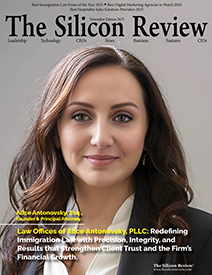50 Innovative Companies to Watch 2020
Tailored Bio-image Analysis Software provider with an exceptional team and offerings: Quantified Biology
The Silicon Review
![]()
Progress in biology is now increasingly dependent on images. Data sets of images are continuing to grow, so it is safe to say that they also contain biologically relevant information. The need to replace the subjective manual measurement and visual inspection by computerized image processing is growing drastically. Reducing manual labor is just one part of the computerized method because it has a wide variety of possibilities, like increasing the accuracy, sensitivity, reproducibility, and objectivity of the data analysis. The image analysis methods help researchers in understanding the features of cell biology and neuroscience.
One of the prominent players in the biological-image analysis segment is Quantified Biology. The company specializes in developing custom-made biological-image analysis solutions for research teams in pharmaceutical companies who perform image-based experimentation for drug discovery in preclinical as well as clinical settings. Quantified Biology’s software solutions save time and improve decision-making by quickly processing thousands of images while performing a non-biased, deep analysis. Unlike generic image analysis tools, Quantified Biology`s solutions address the specific research question at hand. Allowing processing of a single image up through a full set of images, and also secondary statistical analyses and result visualizations, the software enables scientists at pharma to easily scale-up their research programs and to identify potential therapeutic compounds in a high-throughput manner. The company develops the first draft of the algorithm within one or two weeks. After that, the user evaluates it and decides whether to proceed with software development or not. This allows full cost vs. value assessment by the user. The development time of fully functional, dedicated analysis software is between one and two months. At the end of this time period, the user receives custom-made software as a desktop or web-deployed application that can be adjusted or enhanced based on research developments.
Quantified Biology was founded in 2019, and it is based in New York City.
In conversation with Shahar Barbash, Founder and CEO of Quantified Biology
Q. How can researchers scale-up their research programs with custom-made biological image analysis solutions?
As an example use case, myelination is a fundamental biological process that is interrupted in many neurodegenerative diseases. Our software analyzes the myelination status of individual cells based on microscope images of cell-cultures. It supports the processing of a single image up through a full set of images and also provides for secondary statistical analyses and result visualizations. In this way, the software enables scientists to identify potential therapeutic compounds in a high-throughput manner. While before using our software, researchers had to analyze myelination status manually, a biased and highly non-efficient method, today they can move fast and reliably screen through potential compounds.
Q. Tell us about the security measures implemented by you to secure your solutions.
On the Intellectual Property side, Quantified Biology has four pending patents for developed software. On the scientific side, we build upon our strong team. The company includes four Ph.D. computational biologists, from The Hebrew University of Jerusalem and The Weizmann Institute, Israel. This core team develops the algorithms and software and has extensive experience in gene expression analysis, genomic and molecular structure analyses, and bio-image analysis. The company`s board of Directors includes Michael Levitt, a professor at Stanford University and Nobel Laureate in Chemistry and Fernando Gómez-Baquero, a Ph. D. in Nanoscale Engineering and Director of Runway and Spinouts at Jacobs institute, Cornell-Tech
Q. What are the challenges addressed by your custom-made biological image analysis solutions?
Due to significant developments in microscopy automation in recent years, large amounts of high-quality images are now efficiently being collected by the pharmaceutical industry for research purposes. However, analyzing these images to extract meaningful insights has become the research bottle-neck. A large portion of these images is not analyzed and not used to advance the process of drug development.
We develop software that mimics what the human eye does when a researcher analyzes an image in different types of optical microscopy (fluorescent and non-fluorescent), two-photon, and others.
- In contrast to Machine Learning methods, our approach does not require large annotated databases on which to train a model (these databases typically do not exist for discovery research)
- We have straightforward and fast validation
- We have full algorithm interpretability and explainability (‘glass box’ ‘black box’).
Importantly, scientists using our software reported that they identified experimental effects that would have been otherwise missed.
Q. Image analysis software and algorithms can be expensive to buy. How cost effective is your offering?
From our experience, the most expensive for a drug company is to purchase software that simply does not allow them to analyze their experimental data properly. More often than not, after purchasing a generic software, the researcher discovers the limitation of the software and end up neglecting it altogether. This scenario is a real waste of money, time, and the workforce. Perhaps even more important than that, performing a sub-optimal analysis could end up missing important experimental effects, thereby missing potential leads. This could translate into losing millions of dollars down the road of research. Researchers using our software report saving time, manpower, and, most importantly, already show identifying experimental effects. In addition, before purchasing our software, the user already knows how well the software performs and can reliably perform a cost vs. value assessment.
Q. How do you market your services?
Until now, we have broadened our clientele mainly by word of mouth. This had brought us to where we are today. However, looking forward, we would soon have to think of more conventional marketing strategies.
Meet the leader behind the success of Quantified Biology
Shahar Barbash, Ph.D. in Computational Biology is the CEO and founder of Quantified Biology and a startup-fellow at Cornell-Tech. Before that Dr. Barbash was a postdoc fellow at The Rockefeller University.
_2025-12-15_12-44-58.webp)


_2025-11-17_06-38-14.webp)

 (1)_2025-10-21_13-35-14.webp)
